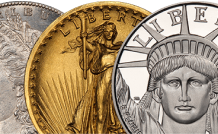
By Mike Fuljenz
The price for a single Bitcoin peaked at $19,783.21 on December 17, 2017. On August 9, 2018, the quoted price was $6,475, down 67% in less than eight months. This decline was very predictable since Bitcoin was not a “real” financial market before late 2017. You could buy or sell Bitcoin on electronic exchanges, but you could not sell Bitcoins “short,” which you could do with most other financial products. Traders can sell stocks or gold or any other financial product short, which means they can “borrow” the product to sell it now, hoping they can buy it back later (“cover their shorts”) at a cheaper price, pocketing the difference.
Last December 11, the Chicago Board of Exchange (CBOE) launched Bitcoin futures accounts. At the time, this move was widely seen as a sign that Bitcoins were finally being “legitimized” as a valid global currency, but that sword can cut two ways. These CBOE accounts allowed “shorting” of Bitcoins, which happened almost immediately, sending Bitcoin prices down 65% (below $7,000) by February 6, 2018.
In the last few months, we have heard rumors about thefts from cryptocurrency accounts by Russian hackers being used to meddle in U.S. elections and other mischief. We don’t know if that’s true, as the Russians certainly have access to a lot of cash from other sources, but now we have confirmation from the July 16 Wall Street Journal (“Thefts of Cryptocurrencies Mount”) that many cryptocurrency accounts have been subject to massive thefts. Since 2011, according to Autonomous Research, a London-based financial-services research firm, there have been 56 cyber-attacks directed at cryptocurrency exchanges, initial coin offerings, and other digital-currency platforms around the world, causing a total of hacking-related losses to reach $1.63 billion. The two biggest hacks were in Japan: the Mt. Gox exchange in 2014 and Coincheck in January 2018, totaling nearly $1 billion in losses. The most recent loss was last month, when hackers stole $23.5 million in cryptocurrencies from an Israeli platform called Bancor.
There’s an old saying, “What one man can invent, another man can circumvent.” Clever programmers created Bitcoin and hundreds of other cryptocurrencies, but an invisible army of other, even more clever hackers are busily working around the clock finding ways to burrow into those electronic “safe” places.
The crypto-crowd is proud of their lack of government regulation, but that independence has backfired on them. They have nobody to turn to for protection. When these private exchanges store cryptocurrencies for customers, that makes these exchanges “sitting ducks,” says the Journal: “Thieves who manage to break in can do something akin to robbing a bank.” One cyber-security expert said that cryptocurrency exchanges are “easy to breach, with minimum effort and expense from attackers and with maximum return on investment.” There have been five such robberies that netted more than $800 million this year alone.
By contrast, U.S. gold and silver coins have a long-term track record of physical asset reliability and are impervious to hackers. Although the Chinese have accelerated their pace of counterfeiting bullion and rare coins, the coin industry has helped with the effort to expose and prosecute these attempts. Choose the right coin dealer – one who is adept in authentication and can counsel you in storing and preserving your coins in safe deposit boxes near you.
Goldman Sachs Reinforces $1,450 Gold Target for 2019
Standing firm against the mainstream’s bearish views on gold, Goldman Sachs is sticking with its $1,450 gold price projection for 2019 – a price level not seen since May 9, 2013. Goldman is also taking a contrarian position on the commodities sector, which has fallen on hard times this year. The firm reports being “overweight” in commodities since they expect a 10% rally over the next 12 months.
Goldman sees more gold demand coming from China. It also considers gold a historical “hedge for policy uncertainty and downside global growth risks – the exact fears which are now on the rise.” With tensions rising over trade war and product piracy in China, election meddling and saber-rattling in Russia, war threats by Iran, a shaky nuclear deal in North Korea, and a controversial U.S. President under assault by his enemies in a mid-term election year, there is plenty of “policy uncertainty and global risk” out there now.
Gold remains in the summer doldrums, but the dog days of summer are almost over. Historically, the best months for gold are about to begin, while the worst months for the stock market are in their early stages. In the last 20 years, August and September are the two worst months for the stock market. By contrast, September is gold’s best month.
Mike Fuljenz, president of Universal Coin & Bullion in Beaumont, Texas, is a leading coin expert and market analyst whose insightful writing and consumer advocacy have earned major honors from the ANA, PNG, NLG, and the Press Club of Southeast Texas. His website is UniversalCoin.com.
Want to receive COINage magazine in your mailbox or inbox? Subscribe today!













